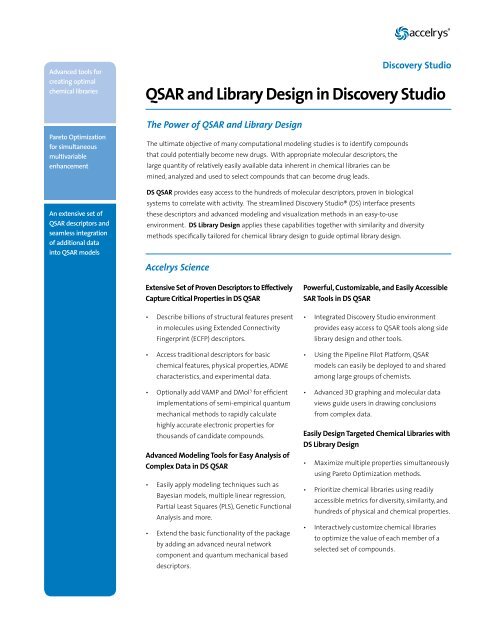QSAR and Library Design in Discovery Studio
QSAR and Library Design in Discovery Studio
QSAR and Library Design in Discovery Studio
You also want an ePaper? Increase the reach of your titles
YUMPU automatically turns print PDFs into web optimized ePapers that Google loves.
Advanced tools forcreat<strong>in</strong>g optimalchemical libraries<strong>Discovery</strong> <strong>Studio</strong><strong>QSAR</strong> <strong>and</strong> <strong>Library</strong> <strong>Design</strong> <strong>in</strong> <strong>Discovery</strong> <strong>Studio</strong>Pareto Optimizationfor simultaneousmultivariableenhancementAn extensive set of<strong>QSAR</strong> descriptors <strong>and</strong>seamless <strong>in</strong>tegrationof additional data<strong>in</strong>to <strong>QSAR</strong> modelsThe Power of <strong>QSAR</strong> <strong>and</strong> <strong>Library</strong> <strong>Design</strong>The ultimate objective of many computational model<strong>in</strong>g studies is to identify compoundsthat could potentially become new drugs. With appropriate molecular descriptors, thelarge quantity of relatively easily available data <strong>in</strong>herent <strong>in</strong> chemical libraries can bem<strong>in</strong>ed, analyzed <strong>and</strong> used to select compounds that can become drug leads.DS <strong>QSAR</strong> provides easy access to the hundreds of molecular descriptors, proven <strong>in</strong> biologicalsystems to correlate with activity. The streaml<strong>in</strong>ed <strong>Discovery</strong> <strong>Studio</strong>® (DS) <strong>in</strong>terface presentsthese descriptors <strong>and</strong> advanced model<strong>in</strong>g <strong>and</strong> visualization methods <strong>in</strong> an easy-to-useenvironment. DS <strong>Library</strong> <strong>Design</strong> applies these capabilities together with similarity <strong>and</strong> diversitymethods specifically tailored for chemical library design to guide optimal library design.Accelrys ScienceExtensive Set of Proven Descriptors to EffectivelyCapture Critical Properties <strong>in</strong> DS <strong>QSAR</strong>• Describe billions of structural features present<strong>in</strong> molecules us<strong>in</strong>g Extended ConnectivityF<strong>in</strong>gerpr<strong>in</strong>t (ECFP) descriptors.• Access traditional descriptors for basicchemical features, physical properties, ADMEcharacteristics, <strong>and</strong> experimental data.• Optionally add VAMP <strong>and</strong> DMol 3 for efficientimplementations of semi-empirical quantummechanical methods to rapidly calculatehighly accurate electronic properties forthous<strong>and</strong>s of c<strong>and</strong>idate compounds.Advanced Model<strong>in</strong>g Tools for Easy Analysis ofComplex Data <strong>in</strong> DS <strong>QSAR</strong>• Easily apply model<strong>in</strong>g techniques such asBayesian models, multiple l<strong>in</strong>ear regression,Partial Least Squares (PLS), Genetic FunctionalAnalysis <strong>and</strong> more.• Extend the basic functionality of the packageby add<strong>in</strong>g an advanced neural networkcomponent <strong>and</strong> quantum mechanical baseddescriptors.Powerful, Customizable, <strong>and</strong> Easily AccessibleSAR Tools <strong>in</strong> DS <strong>QSAR</strong>• Integrated <strong>Discovery</strong> <strong>Studio</strong> environmentprovides easy access to <strong>QSAR</strong> tools along sidelibrary design <strong>and</strong> other tools.• Us<strong>in</strong>g the Pipel<strong>in</strong>e Pilot Platform, <strong>QSAR</strong>models can easily be deployed to <strong>and</strong> sharedamong large groups of chemists.• Advanced 3D graph<strong>in</strong>g <strong>and</strong> molecular dataviews guide users <strong>in</strong> draw<strong>in</strong>g conclusionsfrom complex data.Easily <strong>Design</strong> Targeted Chemical Libraries withDS <strong>Library</strong> <strong>Design</strong>• Maximize multiple properties simultaneouslyus<strong>in</strong>g Pareto Optimization methods.• Prioritize chemical libraries us<strong>in</strong>g readilyaccessible metrics for diversity, similarity, <strong>and</strong>hundreds of physical <strong>and</strong> chemical properties.• Interactively customize chemical librariesto optimize the value of each member of aselected set of compounds.
<strong>Discovery</strong> <strong>Studio</strong>Figure 1 An <strong>in</strong>teractive MultipleL<strong>in</strong>ear Regression <strong>QSAR</strong> modelshow<strong>in</strong>g correlation betweenactual <strong>and</strong> predicted activities.Selection between the plot <strong>and</strong>table are synchronized.The Gold St<strong>and</strong>ard <strong>in</strong> TechnologyComprehensive – The <strong>QSAR</strong> <strong>and</strong> library design tools<strong>in</strong> <strong>Discovery</strong> <strong>Studio</strong> <strong>in</strong>clude hundreds of usefuldescriptors, multiple well validated model build<strong>in</strong>gtechniques <strong>and</strong> tools specially tailored for customlibrary selection <strong>and</strong> design. These packages caneasily be augmented with powerful add-ons forrapidly generat<strong>in</strong>g quantum mechanical baseddescriptors <strong>and</strong> advanced model<strong>in</strong>g techniques.Proven history – The core technology has undergoneover a dozen years of cont<strong>in</strong>uous <strong>in</strong>novation<strong>and</strong> customer driven improvement, <strong>and</strong> hasdemonstrated dependable performance <strong>in</strong> thepharmaceutical <strong>in</strong>dustry with dozens of publications.Cutt<strong>in</strong>g edge – Accelrys is <strong>in</strong>corporat<strong>in</strong>g newscientific tools to meet current pharmaceuticalneeds <strong>and</strong> we are cont<strong>in</strong>uously work<strong>in</strong>g with ourcustomers to plan for future <strong>in</strong>novation.Easy to use <strong>in</strong>terface – DS 2.0 provides apowerful <strong>and</strong> <strong>in</strong>tuitive user <strong>in</strong>terface. DS 2.0can be deployed either <strong>in</strong> a complete st<strong>and</strong>alonesolution for <strong>in</strong>dividual modelers or as part of anenterprise-level client server <strong>in</strong>stallation for easierprotocol shar<strong>in</strong>g <strong>and</strong> adm<strong>in</strong>istration <strong>in</strong> largermodel<strong>in</strong>g groups.Integrated solution – The DS 2.0 environment, basedon the Pipel<strong>in</strong>e Pilot open operat<strong>in</strong>g platform,<strong>in</strong>tegrates prote<strong>in</strong> model<strong>in</strong>g, pharmacophoreanalysis, <strong>and</strong> virtual screen<strong>in</strong>g as well as thirdpartyapplications for an <strong>in</strong>f<strong>in</strong>itely extensiblevirtual discovery platform. Well-tested applications<strong>in</strong>clud<strong>in</strong>g CHARMm, MODELER, Catalyst, <strong>and</strong> othersare accessible <strong>in</strong> the graphical DS environment, thePipel<strong>in</strong>e Pilot script<strong>in</strong>g <strong>and</strong> protocol developmentenvironment <strong>and</strong> from comm<strong>and</strong>-l<strong>in</strong>e prompts.Parallel comput<strong>in</strong>g – The DS 2.0 platform isoptimized to take advantage of grid <strong>and</strong> clustercomput<strong>in</strong>g as well as multi-core processors torapidly process large tasks.Accelrys is Your Partner <strong>in</strong> ResearchUser community – Accelrys scientific forums<strong>and</strong> presentations at scientific meet<strong>in</strong>gs worldwideprovide opportunities for Accelrys users toexchange ideas <strong>and</strong> share new research.Scientific consult<strong>in</strong>g – Accelrys has dozensof experienced Ph.D.s with expertise <strong>in</strong>implement<strong>in</strong>g scientific solutions for drugdesign that are available for short or long-termengagements to create tailored solutions orperform model<strong>in</strong>g experiments.
<strong>Discovery</strong> <strong>Studio</strong>Figure 2 An <strong>in</strong>teractive 3D plot ofthe first three pr<strong>in</strong>cipal componentsfrom a Pr<strong>in</strong>cipal ComponentAnalysis us<strong>in</strong>g several moleculardescriptors as <strong>in</strong>put. The plot canoptionally be colored by a specifiedproperty.Customer support – Accelrys customers report a98% satisfaction rate with our support team.Committed to <strong>in</strong>novation – With over 100 Ph.D.s <strong>in</strong>the field work<strong>in</strong>g daily with researchers <strong>in</strong> <strong>in</strong>dustry<strong>and</strong> academia, Accelrys is committed to deliver<strong>in</strong>gcutt<strong>in</strong>g-edge technology to our customersWorld lead<strong>in</strong>g scientific advisors – Through our<strong>in</strong>-licens<strong>in</strong>g agreements, partnerships, <strong>and</strong> scientificadvisors many of the world’s foremost experts <strong>in</strong>computational drug design are <strong>in</strong>volved <strong>in</strong> sett<strong>in</strong>gour direction.Biological Validation <strong>and</strong>Comparison2007 – Genetic Functional Analysis module used tostudy fluoroqu<strong>in</strong>olone antibacterials. The resultssuggest specific chemical modifications <strong>and</strong>physical properties for future drug design efforts. 12006 – Effect of 2-am<strong>in</strong>othiazole derivatives onNeuro-cell apoptosis studied us<strong>in</strong>g a <strong>QSAR</strong> modelthat has a 97% correlation to EC 5022003 – A descriptor-based <strong>QSAR</strong> model for hOCT1predicts IC 50values with 95% correlation toobserved data. 3References:1.2.3.Cheg, D. et al., “Relationship of quantitative structure <strong>and</strong> pharmacok<strong>in</strong>etics <strong>in</strong> fluoroqu<strong>in</strong>olone antibacterials”,World J Gastroenterol, 2007, 13(17), 2496-503Jiang FC., et al., “The design <strong>and</strong> synthesis of 2-am<strong>in</strong>othiazole derivatives <strong>and</strong> their <strong>in</strong>hibitory activity on apoptosis”,Yao Xue Xue Bao, 2006, 41(8), 727-34Bednarczyk D., et al., “Influence of molecular structure on substrate b<strong>in</strong>d<strong>in</strong>g to the human organic cation transporter, hOCT”,Mol. Pharmacol, 2003, 63(3), 489-980907
















